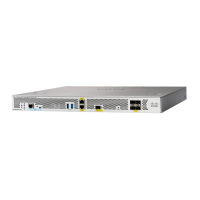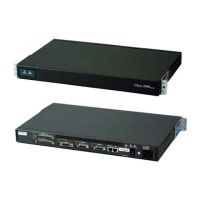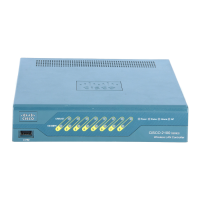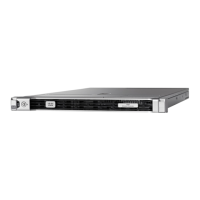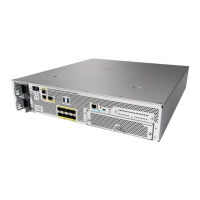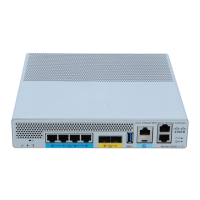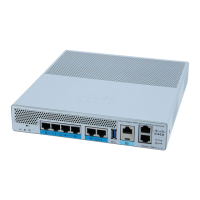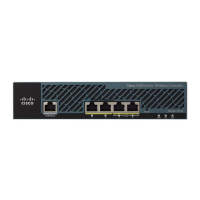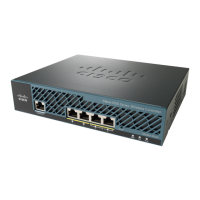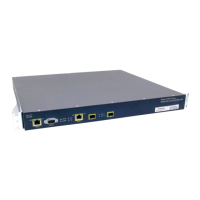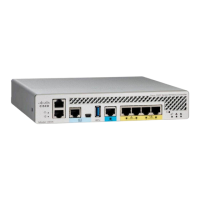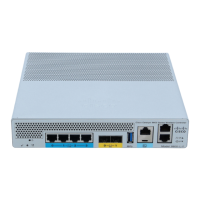E-5
Cisco Wireless LAN Controller Configuration Guide
OL-17037-01
Appendix E Logical Connectivity Diagrams
Catalyst 3750G Integrated Wireless LAN Controller Switch
Because there can be several switches in a stack, the switch_number parameter is used to indicate to
which controller in the stack this session should be directed. Once a session is established, the user
interacts with the controller CLI. Entering exit terminates the session and returns the user to the switch
CLI.
Show Commands
These commands are used to view the status of the internal controller. They are initiated from the switch.
• show platform wireless-controller switch_number summary
Information similar to the following appears:
Switch Status State
1 up operational
2 up operational
• show platform wireless-controller switch_number status
Information similar to the following appears:
Switch Service IP Management IP SW Version Status
------+---------------+---------------+---------------+-------
1 127.0.1.1 70.1.30.1 4.0.52.0 operational
2 127.0.1.2 70.1.31.1 4.0.45.0 operational
• show platform wireless-controller switch_number management-info
sw vlan ip gateway http https mac version
1 0 70.1.30.1/16 70.1.1.1 1 1 0016.9dca.d963 4.0.52.0
2 0 70.1.31.1/16 70.1.1.1 0 1 0016.9dca.dba3 4.0.45.0
Debug Commands
The Wireless Control Protocol (WCP) is an internal keep-alive protocol that runs between the switch and
the controller. It enables the switch to monitor the health of the controller and to report any problems. It
uses UDP and runs over the two internal Gigabit ports, but it creates an internal VLAN 4095 to separate
control traffic from data traffic. Every 20 seconds the switch sends a keep-alive message to the controller.
If the controller does not acknowledge 16 consecutive keep-alive messages, the switch declares the
controller dead and sends a reset signal to reboot the controller.
These commands are used to monitor the health of the internal controller.
This command is initiated from the controller.
• debug wcp ?
where ? is one of the following:
packet—Debugs WCP packets.
events—Debugs WCP events.
Information similar to the following appears:
Tue Feb 7 23:30:31 2006: Received WCP_MSG_TYPE_REQUEST
Tue Feb 7 23:30:31 2006: Received WCP_MSG_TYPE_REQUEST,of type WCP_TLV_KEEP_ALIVE
Tue Feb 7 23:30:31 2006: Sent WCP_MSG_TYPE_RESPONSE,of type WCP_TLV_KEEP_ALIVE
Tue Feb 7 23:30:51 2006: Received WCP_MSG_TYPE_REQUEST
Tue Feb 7 23:30:51 2006: Received WCP_MSG_TYPE_REQUEST,of type WCP_TLV_KEEP_ALIVE
Tue Feb 7 23:30:51 2006: Sent WCP_MSG_TYPE_RESPONSE,of type WCP_TLV_KEEP_ALIVE
Tue Feb 7 23:31:11 2006: Received WCP_MSG_TYPE_REQUEST
Tue Feb 7 23:31:11 2006: Received WCP_MSG_TYPE_REQUEST,of type WCP_TLV_KEEP_ALIVE
Tue Feb 7 23:31:11 2006: Sent WCP_MSG_TYPE_RESPONSE,of type WCP_TLV_KEEP_ALIVE

